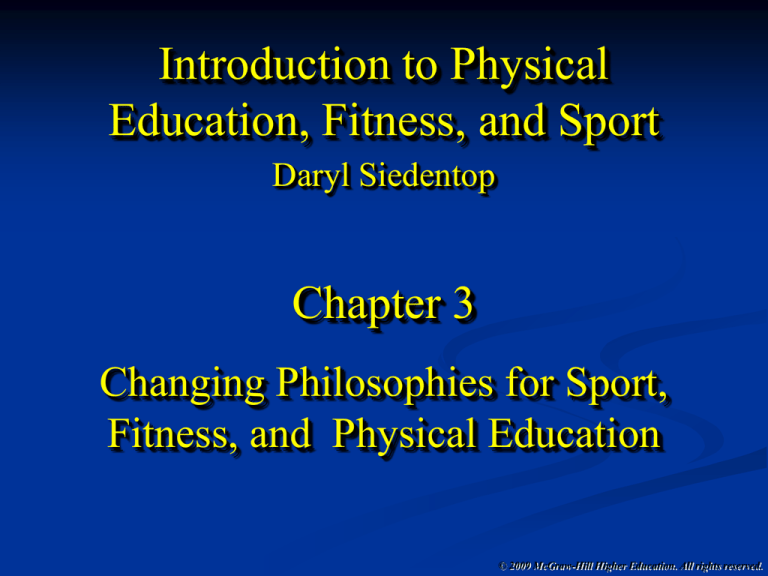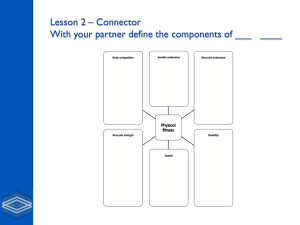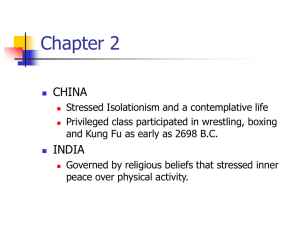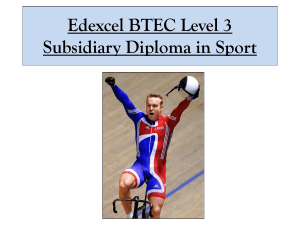
Introduction to Physical
Education, Fitness, and Sport
Daryl Siedentop
Chapter 3
Changing Philosophies for Sport,
Fitness, and Physical Education
© 2009 McGraw-Hill Higher Education. All rights reserved.
Discussion Questions
1. Can you trace the origins of professional
philosophies?
How coherently can you articulate these
philosophical positions?
2
© 2009 McGraw-Hill Higher Education. All rights reserved.
Discussion Questions
2. What current views reflect the influence
of muscular Christianity, the gymnastics
philosophies, or the British fair play
traditions?
In what forms have these notions
survived?
3
© 2009 McGraw-Hill Higher Education. All rights reserved.
Discussion Questions
3. How have masculine and feminine ideals
changed?
What vestiges of the former views still
linger today?
4
© 2009 McGraw-Hill Higher Education. All rights reserved.
Discussion Questions
4. What Physical Education philosophy
best represents your views?
How would you describe the philosophy
underlying the Physical Education
program in the high school that you
attended?
5
© 2009 McGraw-Hill Higher Education. All rights reserved.
Discussion Questions
5. To what extent does progressive
education still dominate school aims
and objectives?
Is progressive education compatible w.
current educational reform?
6
© 2009 McGraw-Hill Higher Education. All rights reserved.
Discussion Questions
6. How does the current wellness movement
differ from the gymnastics philosophies?
Will wellness supplant fitness as a
primary concern? Why? Explain.
7
© 2009 McGraw-Hill Higher Education. All rights reserved.
Discussion Questions
7. Which philosophy seems to dominate
professional sport?
Which one dominates activity at a local
fitness club?
Which one dominates youth sport?
8
© 2009 McGraw-Hill Higher Education. All rights reserved.
Discussion Questions
8. How will the activity choices of
generations X and Y influence the sport
and fitness culture in the future?
9
© 2009 McGraw-Hill Higher Education. All rights reserved.
Some informal Definitions . . .
Politics
10
© 2009 McGraw-Hill Higher Education. All rights reserved.
Some informal Definitions . . .
The study of the nature of being,
existence, or reality.
. . . Deciding on a position regarding the link
between Mind and body, or whether there is more
than one reality
11
© 2009 McGraw-Hill Higher Education. All rights reserved.
Some informal Definitions . . .
The study of values and the nature of values
. . . What values do you try to instill in others?
12
© 2009 McGraw-Hill Higher Education. All rights reserved.
Some informal Definitions . . .
Study of the
a) nature of morals and moral choices made
by persons;
b) rules or standards governing the conduct
of an individual or members of a profession
(e.g., judicial or medical ethics).
. . . Making judgments about the “right” thing to do.
13
© 2009 McGraw-Hill Higher Education. All rights reserved.
Some informal Definitions . . .
Judging what is best for the common good
Politics
14
© 2009 McGraw-Hill Higher Education. All rights reserved.
Politics
These are all areas of study within
the broader field of Philosophy
Your actions and choices (i.e., your behavior)
reflect your philosophy . . .
Your position on issues, your values.
15
© 2009 McGraw-Hill Higher Education. All rights reserved.
Seeing how your philosophy is connected
with those within your field will help you
articulate your views and positions.
Can you articulate your own position and
values about the profession/field you plan
to enter? . . . Try it!
Over time it will evolve, and change . . .
But be sure you have one!
16
© 2009 McGraw-Hill Higher Education. All rights reserved.
Philosophical influences in early American
Sport, Fitness, and Physical Education
Key developments in the 19th Century:
New forms of Government (France & the USA).
Industrial Revolution.
Fundamental changes in economics, population
demographics, and social institutions.
17
© 2009 McGraw-Hill Higher Education. All rights reserved.
Philosophical influences in early American
Sport, Fitness, and Physical Education
Key developments in the 19th & 20th
Centuries in the field . . .(a backdrop):
Physical Education becomes a school subject.
Competitive Sport becomes more accepted.
Fitness becomes valued in its own right.
Importance of Play during childhood is recognized.
18
© 2009 McGraw-Hill Higher Education. All rights reserved.
Main Philosophical influences on Sport,
Fitness, and Physical Education
The Gymnastics Philosophies
Muscular Christianity
Masculinity & Femininity Ideals
Amateurism, Fair Play, & British ideals
Character Education
(See also Box 3.1)
19
© 2009 McGraw-Hill Higher Education. All rights reserved.
The Gymnastics Philosophies
German and Swedish systems emerge
within a period of strong Nationalism.
Both were similar in philosophy.
Main goal: Individual development,
self-reliance.
Yet also strongly linked with National
Defense (i.e., military preparedness).
20
© 2009 McGraw-Hill Higher Education. All rights reserved.
Muscular Christianity
Emerged as Puritanism slowly lost its
grip on the young nation.
Reflects a mutual understanding between
Sport and religion.
Ralph Waldo Emerson: “the first wealth
is health.”
21
© 2009 McGraw-Hill Higher Education. All rights reserved.
Muscular Christianity
Achieving fitness and physical prowess
also serves mental, moral and religious
purposes.
Reached popularity through its variation
from Britain: ARNOLDISM.
ARNOLDISM: Uses Sport & fitness
toward reaching manliness, courage,
patriotism, moral character, team spirit, &
intellectual independence.
22
© 2009 McGraw-Hill Higher Education. All rights reserved.
Masculinity & Femininity Ideals
19th Century: Increased acceptance of
Sport and fitness . .
But only for boys/men!
Vigorous activity and competitive sport
were viewed as harmful and “unladylike”
for girls and women.
This was in stark contrast to prevailing
view of men: Virile, tough, aggressive, etc.
23
© 2009 McGraw-Hill Higher Education. All rights reserved.
Masculinity & Femininity Ideals (cont’d.)
Similar views were held in sport, fitness &
Physical Education environments.
Title IX and feminism
greatly accelerated the
change process for
women.
24
© 2009 McGraw-Hill Higher Education. All rights reserved.
Amateurism, Fair Play, and British Ideals
Development of Sport in the late 1900s
mirrored the growth of British Sport:
Amateurism & Fair Play.
It was the wealthy in Britain who exuded
these characteristics.
Amateur Athletic Union (AAU) formed
in 1888.
25
© 2009 McGraw-Hill Higher Education. All rights reserved.
Character Education Through Physical
Challenges
Kurt Hahn’s educational goal:
Train character over intellect
Fitness was an important component.
40 min. activity breaks were interspersed
daily throughout classroom activities.
26
© 2009 McGraw-Hill Higher Education. All rights reserved.
Character Education Through Physical
Challenges
Youth were challenged through outdoor
activities: Mountain climbing,
sailing expeditions lasting 4 days.
Ergo: The Outward Bound Movement
This orientation formed the basis for the
experiential- and adventure education
movement in the late 20th Century
(e.g., www.elob.org)
27
© 2009 McGraw-Hill Higher Education. All rights reserved.
School Sport and the
New Physical Education . . . The
Philosophical Roots
1924
Thomas
Wood
Johann
Basedow
1740
Clark
Hetherington
John Dewey
Johann
Pestalozzi
Jean-Jacque
Rousseau
Friedrich
Froebel
28
© 2009 McGraw-Hill Higher Education. All rights reserved.
School Sport and the
New Physical Education
Thomas Wood’s work (1893) signaled
the shift from the Gymnastics movement
to the “Education-through-the-physical”
approach.
Based in part on the “progressive education”
principles developed by John Dewey:
29
© 2009 McGraw-Hill Higher Education. All rights reserved.
School Sport and the
New Physical Education
John Dewey’s education agenda:
Social reform through child-centered,
natural education.
Students are active participants . . . Doing is
as important as knowing . . . Mental and
physical cannot/should not be separated.
Thus, natural play, sport and games were
valued highly in “progressive education.”
30
© 2009 McGraw-Hill Higher Education. All rights reserved.
School Sport and the
New Physical Education
John Dewey strongly influenced Clark
Hetherington while at Columbia University.
Hence, the link between progressive
education and “education-through-thephysical.”
Thus, natural play, sport and games were
valued highly in “progressive education.”
31
© 2009 McGraw-Hill Higher Education. All rights reserved.
School Sport and the
New Physical Education . . . The Philosophical
Roots
Rousseau: Children are born “good”
. . . It is their environment that ruins them.
Strong advocate of physical activity, play,
games & gymnastics as sensory experiences
for a more holistic education.
Play could contribute to developing:
Character and competition.
32
© 2009 McGraw-Hill Higher Education. All rights reserved.
School Sport and the
New Physical Education . . . The Philosophical
Roots
Rousseau influenced educators:
Basedow, Pestalozzi, & Froebel.
They each viewed physical activity, play
as central to children’s development.
Play could contribute to developing:
Character and competition.
33
© 2009 McGraw-Hill Higher Education. All rights reserved.
Re-emergence of Play as a Philosophical Concept
Play was the key link among the various
educational philosophers.
Froebel made it the cornerstone of his
views of how children learn.
Became widely accepted as central to
education and life.
Previously, Christianity (i.e., Reformation)
suppressed play behavior as anti-Christian.
34
© 2009 McGraw-Hill Higher Education. All rights reserved.
Re-emergence of Play as a Philosophical Concept
(cont’d.)
Friedrich von Schiller made Play
a legitimate philosophical concept:
“For to speak out once for all, man only
plays when in the full
meaning of the word he is
a man, and he is only
completely a man when
at play.”
(Schiller, 1910)
35
© 2009 McGraw-Hill Higher Education. All rights reserved.
The Early 20th Century:
Philosophies Come Together
Sport, fitness and school-based Physical
Education had become well accepted and
seen as critical to total development
(though still favoring males).
Physical Education proponents also
influenced the YMCA and playground
movements.
Sport, fitness and Physical Education
each began to form their own identity.
36
© 2009 McGraw-Hill Higher Education. All rights reserved.
Philosophical Forces in Sport, Fitness and
Physical Education since 1950’s
1950’s mark a period of increasing
specialization, diversification in each area.
Until the 1950’s the “Education-Throughthe-Physical” had not been challenged.
Rise of new philosophical orientations:
Human Movement
Humanistic Sport & Physical
Education.
Play Education & Sport Education.
37
© 2009 McGraw-Hill Higher Education. All rights reserved.
Philosophical Forces in Sport, Fitness and
Physical Education since 1950’s
“Human Movement” philosophy
First articulated by Rudolph Laban; heavily
promoted by Rosiland Cassidy & Elanor
Metheny.
Became basis for:
a) undergraduate teacher preparation at
UCLA in 1958, and.
b) justifying the academic nature of Physical
Education.
38
© 2009 McGraw-Hill Higher Education. All rights reserved.
Philosophical Forces in Sport, Fitness and
Physical Education since 1950’s
“Human Movement” philosophy (cont’d. )
Framework fostered subsequent specialization
into various sub-disciplines
Offered school programs a more flexible and
open approach to teaching, notably in Elem.
Schools: Movement Education.
Associated teaching styles: Exploration and
guided discovery.
39
© 2009 McGraw-Hill Higher Education. All rights reserved.
Philosophical Forces in Sport, Fitness and
Physical Education since 1950’s
“Human Movement” philosophy (cont’d. )
Still reflected in many of today’s Elem. School
textbooks and school programs & PETE
programs.
Offered school programs a more flexible and
open approach to teaching, notably in Elem.
Schools: Movement Education.
Associated teaching styles: Exploration and
guided discovery.
40
© 2009 McGraw-Hill Higher Education. All rights reserved.
Philosophical Forces in Sport, Fitness and
Physical Education since 1950’s
Humanistic Sport & Physical Education
Humanistic Psychology emerged as a
dominant force in Education during the
60’s/70s, emphasizing personal and social
development.
Don Hellison publishes “Humanistic
Physical Education” (1973) targeting personal
development, interpersonal relationships and
self-expression as primary goals for Physical
Education.
41
© 2009 McGraw-Hill Higher Education. All rights reserved.
Philosophical Forces in Sport, Fitness and
Physical Education since 1950’s
Humanistic Sport & Physical Education
(cont’d.)
A similar movement develops that condemns
abuses in sport (e.g., Scott, 1969: Athletics for Athletes).
Hellison’s framework for developing “personal
and social responsibility” has developed a
strong foothold in school Physical Education,
most notably those serving urban at-risk youth.
42
© 2009 McGraw-Hill Higher Education. All rights reserved.
Philosophical Forces in Sport, Fitness and
Physical Education since 1950’s
Play Education & Sport Education
Traditional philosophies viewed Physical
Education as a means towards other outcomes
(i.e., physical, social, mental & moral).
“Play for play sake” (i.e., the activities are
valuable in and of themselves) emerges as a
new means of explaining the importance of
the subject in schools (first promoted by Elanor Metheny).
43
© 2009 McGraw-Hill Higher Education. All rights reserved.
Philosophical Forces in Sport, Fitness and
Physical Education since 1950’s
Play Education & Sport Education
(cont’d.)
First proposed by Siedentop, it aims to help
students acquire the skills and appreciation for
the activities themselves.
Activities should not
have to be used for
“other” outcomes . . .
44
© 2009 McGraw-Hill Higher Education. All rights reserved.
Philosophical Forces in Sport, Fitness and
Physical Education since 1950’s
Play Education & Sport Education
(cont’d.)
Play Education places motor play (as seen in
Physical Education) alongside music, art and
drama as an institutionalized form of play
within the broader culture.
As such, it is fundamental to our culture .
45
© 2009 McGraw-Hill Higher Education. All rights reserved.
Philosophical Forces in Sport, Fitness and
Physical Education since 1950’s
Play Education &
Sport Education (cont’d.)
Where Play Education was a philosophy, Sport
Education (SE) emerged as a coherent
Curriculum & Instruction model for school
Physical Education programs.
SE seeks to help students become competent,
literate and enthusiastic sportpersons . . . To
foster continued participation and contribution
to creating a healthier sport culture.
46
© 2009 McGraw-Hill Higher Education. All rights reserved.
Philosophical Forces in Sport, Fitness and
Physical Education since 1950’s
Play Education &
Sport Education (cont’d.)
In SE, students are members of a team during
a season in which festivity and team affiliation
is created, a schedule of competition is
completed, records are kept, and a season
champion is determined during a culminating
event.
47
© 2009 McGraw-Hill Higher Education. All rights reserved.
Philosophical Forces in Sport, Fitness and
Physical Education since 1950’s
Experiential & Adventure Education
Based on the character-education models from
the 1800’s.
Follows the core values and principles of
Outward Bound (www.outwardbound.com):
Adventure & challenge.
Compassion & service.
Learning through experience.
Personal development.
Social & environmental responsibility.
48
© 2009 McGraw-Hill Higher Education. All rights reserved.
Philosophical Forces in Sport, Fitness and
Physical Education since 1950’s
Experiential & Adventure Education
Many school Physical Education programs
infuse team building and adventure type
activities.
Includes both in-class and off-campus
experiences (e.g., 2-3 day hiking or canoeing trips).
49
© 2009 McGraw-Hill Higher Education. All rights reserved.
The Fitness Renaissance and Wellness Movement
Fitness is “in” and BIG business.
Targets entire population (i.e., youth
through older adults).
The need for better health is a major
explanation for its current popularity.
HOWEVER, reaching a state of
Wellness is another reason.
50
© 2009 McGraw-Hill Higher Education. All rights reserved.
The Fitness Renaissance and Wellness Movement
Health used to be defined in terms of
the “absence of disease.”
Wellness is defined more broadly:
Absence of disease, as well as the ability to:
cope with daily stressors.
develop and maintain positive
interpersonal relationships.
recognize accomplishment
and personal growth.
think critically and be open to
new ideas
maintain a sense of humor. (fr. Fahey, Insel & Roth, 2007) 51
© 2009 McGraw-Hill Higher Education. All rights reserved.
The Fitness Renaissance and Wellness Movement
Wellness is reached when one can
effectively balance one’s work, play, and
relationships and view each positively. . .
How would you rate your level of
wellness?
Maintaining a physically active lifestyle is
now accepted as a central component of
moving toward wellness.
52
© 2009 McGraw-Hill Higher Education. All rights reserved.
The Fitness Renaissance and Wellness Movement
Traditionally, wellness has been viewed
as a matter of personal responsibility.
HOWEVER, current trends in sedentary
lifestyles and obesity in the population at
large, make it a public health and public
policy concern . . . .
A collective responsibility.
53
© 2009 McGraw-Hill Higher Education. All rights reserved.
The Fitness Renaissance and Wellness Movement
One’s health is strongly influenced by
Socio-economic Status.
Since race and ethnicity is strongly
correlated with SES, health is also
a social and political issue.
54
© 2009 McGraw-Hill Higher Education. All rights reserved.
Lifespan Involvement in Physical Activity:
The new Visions
Physical activity and wellness is
important for ALL (not just children and youth).
New generations are increasingly attracted
to “extreme sports.” . . . . WHY??
Even these activities are becoming more
institutionalized (e.g., Winter Games; X-Games).
Fitness is now also a major focus among
older adults and retirees.
55
© 2009 McGraw-Hill Higher Education. All rights reserved.









